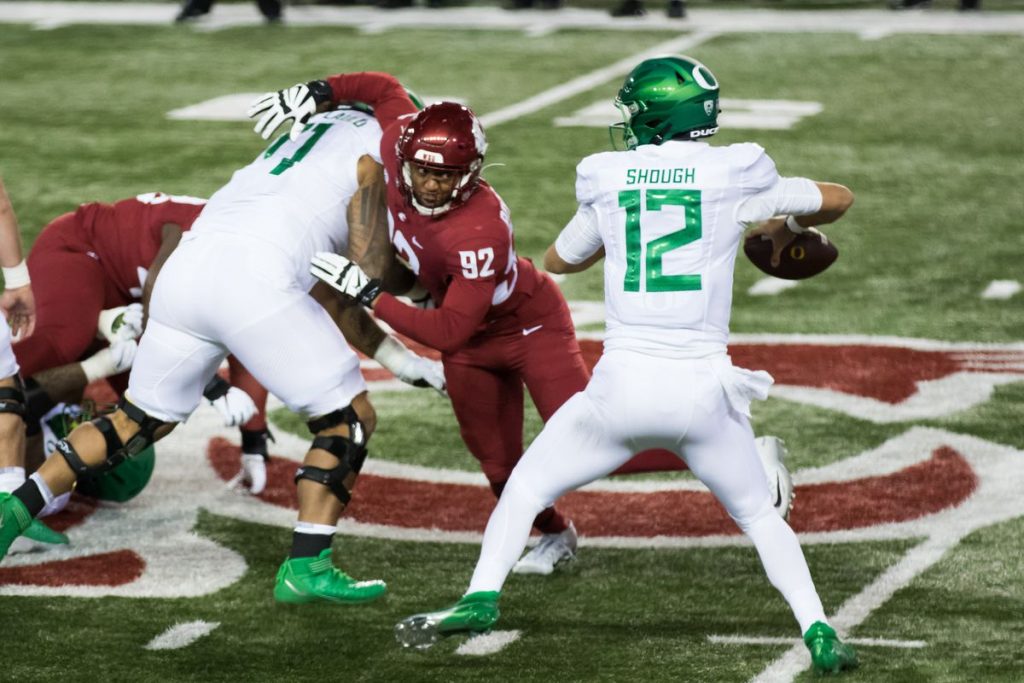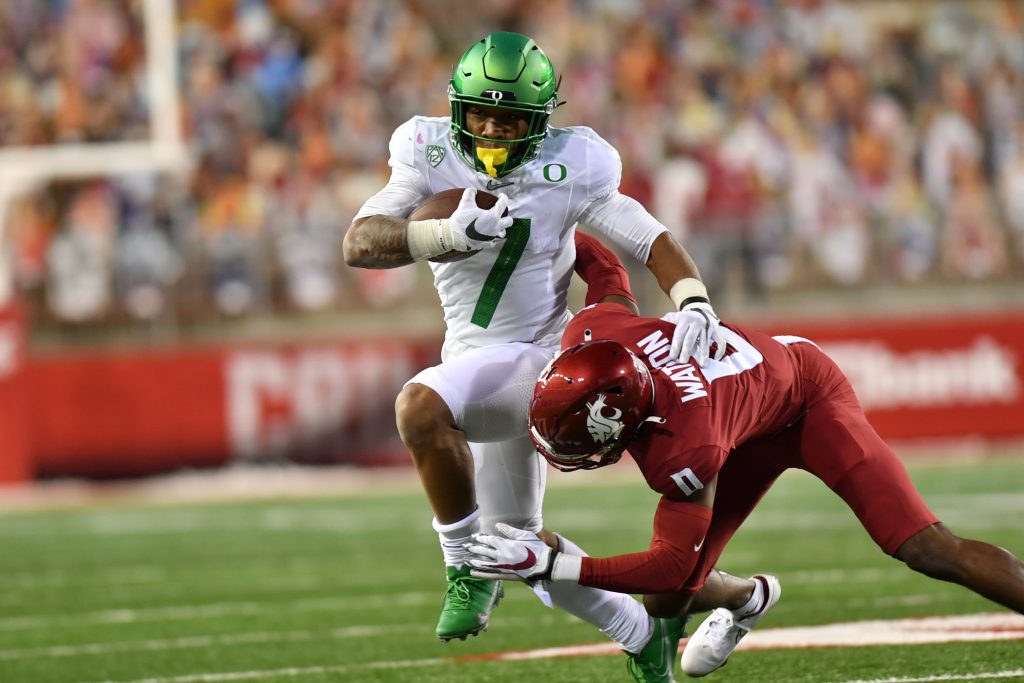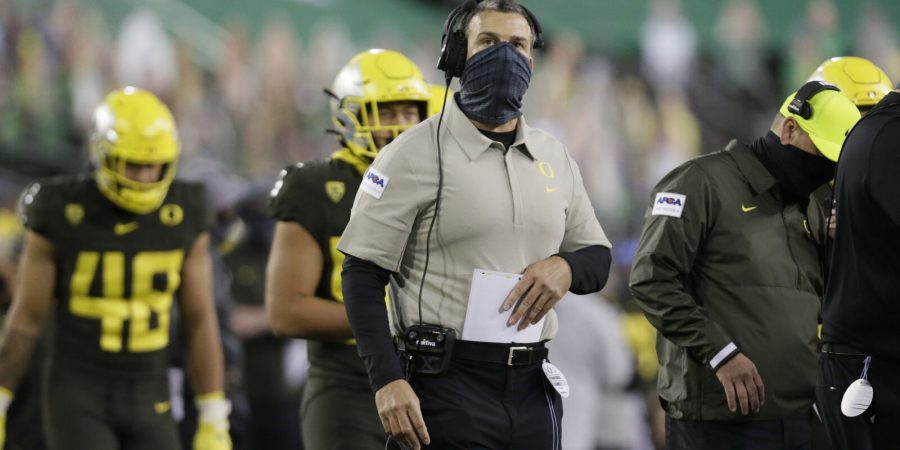So much about what we know and have come to expect with regard to just about everything has been more or less flipped on its head in 2020. Thus, it almost kind of makes sense when you examine the unexpected role reversal of preseason expectations that appears to be taking place between the Oregon offense and defense through two weeks of play.
Of course, we preface all of this with an obvious disclaimer that just two games of a (fingers crossed) seven-game schedule have been played, so making sweeping generalizations one way or the other feels a bit knee-jerky. However, that doesn’t discount the fact there have been some very notable trends that have begun to take shape roughly a quarter of the way through the season.
Entering the year, few would have anticipated the Oregon offense to be operating with the striking level of lethality they have demonstrated over the first two weeks. In fact, you have to go back to the 2013 season to find an Oregon offense within the last decade that has come close to sniffing what the 2020 Ducks are accomplishing on a purely yards per play basis. Through two games this season, the Ducks are averaging an astounding 8.16 yards per game. Over the course of 13 games in 2013, the Ducks averaged 7.55 yards per play.
Again, the current sample size we’re working off of is small, but even if the Oregon offense eventually falls between 6.5 and 7.5 yards per play once the ink dries on 2020, they will share a place amongst some of the most potent offenses in program history.

In place of Justin Herbert, redshirt sophomore quarterback Tyler Shough is proving with each passing week that he can be a very capable triggerman at the helm of this offense. As a matter of fact, Shough’s 166 yards on the ground are the most ever by an Oregon quarterback through two career starts. That’s better than former Duck dual-threat stars Dennis Dixon, Darron Thomas, Vernon Adams, Jeremiah Masoli, and the GOAT, Marcus Mariota. Mix in Shough’s 539 yards and five touchdowns through the air to go along with his 67.9 completion percentage, and we’re talking about a player who is emerging as a real difference maker.
Yet, that really only scratches the surface when it comes to assessing the offensive superlatives.
Up front, Oregon’s offensive line has surpassed even the most bullish expectations from Duck fans through two games. After boasting the nation’s most experienced offensive line group in 2019, the Ducks came into 2020 with the unenviable label of being the nation’s least experienced offensive line. You would never know it though, as this unit has not only kept their quarterback clean and played near mistake-free football (just one penalty incurred thus far), but they’ve also been dominating at the point of attack, paving the way for Shough, CJ Verdell, Travis Dye, and Cyrus Habibi-Likio to the tune of 538 yards and six touchdowns on the ground.
For perspective, Oregon’s 269 rushing yards per game average through two weeks was surpassed on just three different occasions in the previous two seasons combined.

And while Shough and the big guys in the trenches deserve the attention they’re receiving, first year offensive coordinator Joe Moorhead may be the one who deserves the lion’s share of the praise. By any reasonable measure, Moorhead’s offense has outperformed the offenses that were orchestrated by former offensive coordinator Marcus Arroyo, which often stood as an example of frustration for Duck fans who rightfully expected more from an offense featuring the talents of Herbert and one of the best offensive lines in school history. Moorhead’s forward-think and multi-faceted approach has been more or less an overnight success, which comes in spite of COVID-19, the concerning rash of turnovers (five, to be exact), and the suspect decision-making that Shough and others have been responsible for in back-to-back weeks.
The yin to the offense’s yang, however, has been the Oregon defense. Lauded as the best defensive unit in the Pac-12, despite the graduation of Troy Dye and the opt-outs of Jevon Holland, Thomas Graham, and Brady Breeze, the Ducks have yet to show anything close to resembling the quality of the defenses they fielded in 2018 or 2019.
Takeaways and havoc plays have long been a staple of defenses coached by defensive coordinator Andy Avalos, though the Ducks have yet to register a single takeaway this season facing a pair of offenses that were led by a pair of woefully inexperienced quarterbacks.
After ranking tied for eighth nationally in takeaways (27) a season ago, it’s been more than a decade since the Ducks have started a season failing to register a single takeaway through their first two games. Moreover, the stunning lack of negative plays from scrimmage has also been an odd development in the early going. In 2019, the Ducks ranked atop the conference in both tackles for loss (97.0) and sacks (41.0). Returning a host of starters and rotational regulars (plus a handful of highly-touted freshmen) in 2020, the Ducks were expected to reprise their role as Pac-12 leaders in said categories, yet currently rank tied for seventh in the conference in tackles for loss (7.0) and tied for dead last in sacks (1.0) through two weeks.
Making matters even worse, the Ducks have been woeful in limiting big plays to start the year. Not only does Oregon rank ninth in the Pac-12 in yards per play surrendered (6.78), but they are dead last in the conference in opponent plays of 20 yards or more (13).
The poor tackling and general lack of continuity can certainly be in part blamed on an offseason upended by COVID, but only to a certain extent. If the Ducks are unable to snap out of their defensive funk following games vs. UCLA and at Oregon State in the next two weeks, it could be fair to wonder whether the defense – and not the offense as was expected – is this team’s true Achilles’ heel in 2020.
Photo: Oregon head coach Mario Cristobal (Andy Nelson/The Register-Guard)

